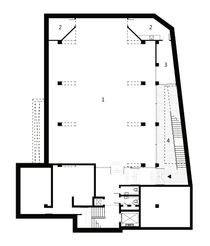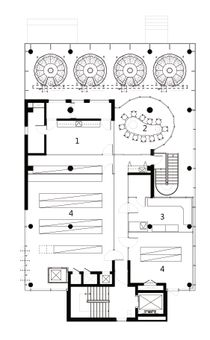
Choonwondang Oriental Clinic & Museum
Text description provided by architect.
The Doneui-dong/Nakwon-dong area of Jongno, where the Choonwondang Oriental Clinic & Museum is located, is twisted, complicated, and narrow, a ‘bowel’ in the city of Seoul.
The streets are too confined for construction vehicles to pass through; shabby love hotels are everywhere; cheap eateries sell cold noodles for just under 4 US dollars; the area still evokes its own past, a once infamous red-light district called Jongsam.
As you enter the area, the clock seems to run back twenty or thirty years. An ideal location for a Seoul film noir, one may think.
Here history runs deep. To the east are the walls of the Jongmyo Shrine, to the west is the Pagoda Park. Flanked by Donhwamun-ro, this is one of the oldest areas in Seoul.
The Choonwondang Clinic has been located here since 1953, founded right after the Korea War.
Originally established in 1847 in Bakcheon, North Korea, and handed down through seven generations, the clinic regards itself as a committed guardian of Seoul’s historic center.
The client stated that despite the area’s deterioration the clinic was to remain, and that the new building was to represent new visions for the area’s future. An idea for an open and transparent building was thus conceived.
The Choonwondang Oriental Clinic & Museum is a mixed-use building, as the name suggests. The functional programming is based on the Essence-Energy-Spirit Theory of Oriental medicine.
Doctors’ offices and a herbal-medicine production room seek to enliven the essence of the body; the basement hall, where various cultural activities such as exhibitions, seminars, and concerts take place, is intended to enhance the energy of the mind; the museum, where the history of the clinic itself and traditional relics of Oriental medicine are on display, promotes the spirit of the medical profession.
Located at various parts of the building, these spaces are open to visitors and well connected with the surroundings. Materials are also based on the philosophy of Oriental medicine.
The use of paint, for example, is kept to a minimum. Instead, raw materials such as basalt, exposed concrete with the texture of wood, wood itself, and glass are the main finishing elements; matte stainless steel and galvanized steel are also used.
By using natural materials we wanted to show our respect for the philosophy of natural herbal medicine.
The herbal medicine production room was the key element of the design. It is at the same time mechanical and sacred, an ‘intestine’ of these bowels of an ancient city.
We wanted to deliver a poetic message with this complicated machine, the patent for which belongs to the clinic. We had the room face north to minimize the hazards of direct sunlight.
It took a great deal of technical coordination and visual adjustments to transform this mechanical contraption into a design statement. The result is a new type of Oriental clinic, in which internal process becomes a part of urban streetscape.
The Choonwondang Oriental Clinic & Museum is the largest, most complicated, and most heavily laden with meanings among all the series of projects in Seoul’s historic center that my office has yet undertaken.
The context of an old city plus a program for an Oriental clinic gave us another chance to realize our belief in ‘the old creating the new’; it was a rare opportunity to combine in one project the two eternal antipodes of architecture, the site and the program.



































